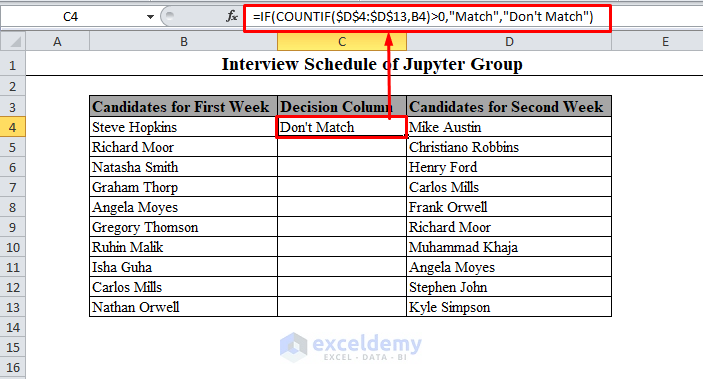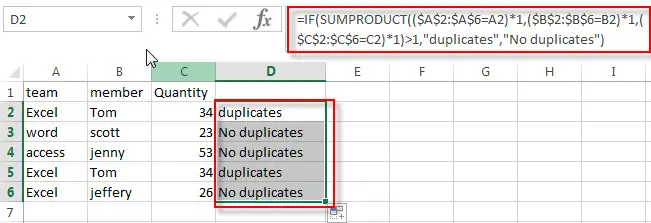

- #EXCEL FIND DUPLICATES MATCH CASE HOW TO#
- #EXCEL FIND DUPLICATES MATCH CASE FREE#

These can be invoices, product Id's, names or any other data. Supposing you have a list of items in column A that you want to check for duplicates.
#EXCEL FIND DUPLICATES MATCH CASE HOW TO#
How to find duplicate records including 1 st occurrences Depending on whether you want to find duplicate values with or without first occurrences, there's going to be a slight variation in the formula as shown in the following examples. The easiest way to detect duplicates in Excel is using the COUNTIF function.
#EXCEL FIND DUPLICATES MATCH CASE FREE#
Duplicate Remover for Excel - fast and formula free way to locate duplicates.Other ways to deal with duplicates (highlight, remove, select, copy or move).How to find case-sensitive duplicates in Excel.
 Search for duplicates without 1 st occurrences. Check for duplicates with 1 st occurrences. These solutions work in all versions of Excel 365, Excel 2019, Excel 2016, Excel 2013 and lower. In one of our previous tutorials, we discussed various ways to compare two tables or columns for duplicates.Īnd today, I'd like to share a few quick and effective methods to identify duplicates in a single list. While working with a large Excel worksheet or consolidating several small spreadsheets into a bigger one, you may find lots of duplicate rows in it. You will also learn how to count instances of each duplicate record individually and find the total number of dupes in a column, how to filter out duplicates, and more. You will learn a few formulas to identify duplicate values or find duplicate rows with or without first occurrences. Note: this is an array formula and must be entered with control + shift + enter, except in Excel 365.The tutorial explains how to search for duplicates in Excel. In the example below, we are using INDEX and MATCH and boolean logic to match on 3 columns: Item, Color, and Size: In other words, a lookup that matches on more than one column at the same time. One of the trickiest problems in Excel is a lookup based on multiple criteria. Note: this is an array formula and must be entered with control + shift + enter, except in Excel 365. Essentially, we use MATCH to find the smallest difference. Then we use INDEX to retrieve the associated trip from column B. In the example below, we use the MIN function together with the ABS function to create a lookup value and a lookup array inside the MATCH function. Closest matchĪnother example that shows off the flexibility of INDEX and MATCH is the problem of finding the closest match. However, you use the EXACT function with INDEX and MATCH to perform a lookup that respects upper and lower case, as shown below: Case-sensitive lookupīy itself, the MATCH function is not case-sensitive. Simply put, this just means a lookup where the ID column is to the right of the values you want to retrieve, as seen in the example below: One of the key advantages of INDEX and MATCH over the VLOOKUP function is the ability to perform a "left lookup". Video: How to debug a formula with F9 (to see MATCH return values) Left lookup Video: How to do a two-way lookup with INDEX and MATCH Note: you could use Data Validation to create dropdown menus to select salesperson and month. For example, to return the February sales number for Frantz, we provide the range C3:E11 with a row 5 and column 2:Īnd INDEX correctly returns $10,525, the sales number for Frantz in March.
Search for duplicates without 1 st occurrences. Check for duplicates with 1 st occurrences. These solutions work in all versions of Excel 365, Excel 2019, Excel 2016, Excel 2013 and lower. In one of our previous tutorials, we discussed various ways to compare two tables or columns for duplicates.Īnd today, I'd like to share a few quick and effective methods to identify duplicates in a single list. While working with a large Excel worksheet or consolidating several small spreadsheets into a bigger one, you may find lots of duplicate rows in it. You will also learn how to count instances of each duplicate record individually and find the total number of dupes in a column, how to filter out duplicates, and more. You will learn a few formulas to identify duplicate values or find duplicate rows with or without first occurrences. Note: this is an array formula and must be entered with control + shift + enter, except in Excel 365.The tutorial explains how to search for duplicates in Excel. In the example below, we are using INDEX and MATCH and boolean logic to match on 3 columns: Item, Color, and Size: In other words, a lookup that matches on more than one column at the same time. One of the trickiest problems in Excel is a lookup based on multiple criteria. Note: this is an array formula and must be entered with control + shift + enter, except in Excel 365. Essentially, we use MATCH to find the smallest difference. Then we use INDEX to retrieve the associated trip from column B. In the example below, we use the MIN function together with the ABS function to create a lookup value and a lookup array inside the MATCH function. Closest matchĪnother example that shows off the flexibility of INDEX and MATCH is the problem of finding the closest match. However, you use the EXACT function with INDEX and MATCH to perform a lookup that respects upper and lower case, as shown below: Case-sensitive lookupīy itself, the MATCH function is not case-sensitive. Simply put, this just means a lookup where the ID column is to the right of the values you want to retrieve, as seen in the example below: One of the key advantages of INDEX and MATCH over the VLOOKUP function is the ability to perform a "left lookup". Video: How to debug a formula with F9 (to see MATCH return values) Left lookup Video: How to do a two-way lookup with INDEX and MATCH Note: you could use Data Validation to create dropdown menus to select salesperson and month. For example, to return the February sales number for Frantz, we provide the range C3:E11 with a row 5 and column 2:Īnd INDEX correctly returns $10,525, the sales number for Frantz in March. 
From the discussion above, we know we can give INDEX a row and column number to retrieve a value. Let's say we want to write a formula that returns the sales number for February for a given salesperson. Now that we've covered the basics of INDEX and MATCH, how do we combine the two functions in a single formula? Consider the data below, a table showing a list of salespeople and monthly sales numbers for three months: January, February, and March. Match type defaults to 1, which means approximate match, so it's important to provide a value. In many cases you will want to use zero (0) to force exact match behavior. Match type is important and controls whether matching is exact or approximate. Important: The last argument in the MATCH function is match type. Video: How to use MATCH for exact matches Same result with a horizontal range, MATCH returns 3.








 0 kommentar(er)
0 kommentar(er)
